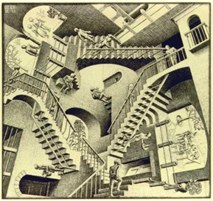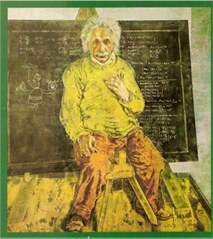Visual Arts
Texts by Dr. Antonio Moreno González
The same occurred with the plastic and visual arts as with literature. Relativity was particularly influential: of all Einstein's works, this is the one that really made its way onto the street and into popular culture, under the misguided slogan "everything is relative". Schoenberg's music, Calder's mobiles and Picasso's cubism suggest that the new art and the new form of experimenting with images and sounds did not occur in isolation from other intellectual movements, especially Einsteinian relativity. Whether this really was the case or not remains to be seen, but Einstein himself certainly did not accept any such association. Holton cites this answer by Einstein to an art historian:
"The essence of the theory of relativity has been incorrectly understood in [your article], granted that this error is suggested by the attempts at popularization of the theory. For the description of a given state of facts one uses almost always only one system of coordinates. The theory says only that the general laws are such that their form does not depend on the choice of the system of coordinates. This logical demand, however, has nothing to do with how the single, specific case is represented. A multiplicity of systems of coordinates is not needed for its representation. It is completely sufficient to describe the whole mathematically in relation to one system of coordinates.
This is quite different in the case of Picasso's painting, as I do not have to elaborate any further. Whether, in this case, the representation is felt as artistic unity depends, of course, upon the artistic antecedents of the viewer. This new artistic 'language' has nothing in common with the Theory of Relativity."
These remarks by Einstein did not prevent painters, sculptors and architects from utilising their own concept of relativity in their works. Popular examples of these ideas include Escher's Relativity and the Einstein Tower in Potsdam designed by architect Erich Mendelsohn. A number of painters, too, sought to immortalise the figure of Albert Einstein, among them Andy Warhol.
Einstein's fame and popularity were also a tempting motif for the movie industry. In several films his name, his image, his relativity... even his eyes (Spielberg used him as a model in designing ET's eyes) are used more or less felicitously. Of all the films in which he appears, perhaps the most striking was Virtual Obsession , made in 1998. Einstein is a virtual scientist, a "post-biological" man as the film puts it, who sometimes escapes from the limits of the digital screen to incorporate himself into everyday life as an intangible but decisive being because of his creative capacity and his morality. He is a figure for eternity who can be turned to in our hour of need, as his assistant in the real world does. In love with the Einstein system, she integrates herself with him and dies of "virtual aneurysm". Einstein, in real life, died of a burst aortic aneurysm in his abdominal aorta.
Despite Einstein's refusal to accept what others saw as the influence of his relativist theories on other areas of human activity, in terms of artistic creation, Einstein not only took pleasure in contemplating and performing works of art (especially music), he even considered that scientific activity contained a major artistic component. Those who worked with him tell how he valued the beauty of physical theories, especially when they attained a degree of simplicity and clarity. This was the case with the Newtonian and Maxwellian syntheses, achievements that were outstanding for their simplicity in getting their ideas across.
According to Einstein, like the artist, the scientist must have an intuitive capacity to "see" harmony and the scientific structure on which nature is sustained. In this creative undertaking, the scientist, he said, must "feel free to play with the concepts". A good illustration of this link between science and art is to be found in the book by Arthur I. Miller, Einstein, Picasso. Space, Time, and the Beauty That Causes Havoc (New York, 2001).

Relativity, by the Dutch architect Maurits Cornelis Escher (1898 - 1972)

Portrait of Albert Einstein by Hans Erni, 1957
